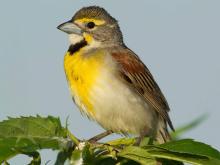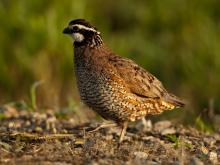Birds
Media

Species Types
Scientific Name
Zonotrichia leucophrys
Description
The white-crowned sparrow is a large sparrow with a bold black-and-white striped crown, a clear gray breast, and a pink beak. It is one of our most common and widespread winter sparrows.
Media

Species Types
Scientific Name
Zonotrichia querula
Description
The Harris's sparrow's black bib, face, and crown contrast sharply with its gray cheeks, white belly, and pink beak. In winter, seek this bird in brushy fields and open woods in western Missouri.
Media

Species Types
Scientific Name
Spiza americana
Description
Like a cross between a meadowlark and a sparrow, the dickcissel is common in prairies, pastures, and fields. Atop fences and tall weeds, it sings its buzzy “dick-dick-dickcissel” into the bright sunshine.
Media

Species Types
Scientific Name
Actitis macularius
Description
The spotted sandpiper is one of our best-known shorebirds, with its spotted breast, orange bill, unique teetering, tail-bobbing gait, and enormous breeding range.
Media

Species Types
Scientific Name
Cardinalis cardinalis
Description
The male northern cardinal is a bright red bird with a head crest and black mask. An excellent singer, this familiar backyard bird is beloved by many.
Media

Species Types
Scientific Name
Pheucticus ludovicianus
Description
The rose-breasted grosbeak's song is a beautiful, robin-like carol. Grosbeaks are chubby birds with heavy bills used for gathering and eating beetles, seeds, and fruits.
Media

Species Types
Scientific Name
Tympanuchus cupido
Description
The greater prairie-chicken breeds in select grasslands in the spring, filling the air with their unusual booming calls. With their numbers dwindling, this rare bird needs strong conservation support.
Media

Species Types
Scientific Name
Bonasa umbellus
Description
Restoration efforts are raising the numbers of this chickenlike bird in our state. Look for brown, rufous, and gray streaks, bars, and bands. A dark ruff on the neck appears on both sexes but is used by the male in courtship displays.
Media

Species Types
Scientific Name
Colinus virginianus
Description
With its distinctive, clear “bob-WHITE!” calls, the official state game bird is often heard before it’s seen, especially since its brown-and-white coloration helps it to disappear into its habitat.
Species Types
Scientific Name
Perdix perdix
Description
An introduced gamebird from Eurasia, the gray partridge occurs mostly along the US-Canada border to our northwest. It may at times appear in northwest Missouri.
See Also







Media

Species Types
Scientific Name
Hemaris diffinis
Description
The snowberry clearwing is a moth that confuses people because it looks like a bumblebee and flies like a hummingbird!
Media

Species Types
Scientific Name
Hyles lineata
Description
The white-lined sphinx moth sometimes confuses people because it flies, hovers, and eats from flowers like a hummingbird. The adults often fly during daylight hours as well as in the night and are often found at lights.
Media

Species Types
Scientific Name
Darapsa myron
Description
The Virginia creeper sphinx moth is common in woods and brushy areas and comes to lights at night. The larvae eat Virginia creeper and grape leaves.
Media

Species Types
Scientific Name
Perimyotis subflavus (formerly Pipistrellus subflavus)
Description
Tri-colored bats, formerly called eastern pipistrelles, are relatively small and look pale yellowish or pale reddish brown. The main hairs are dark gray at the base, broadly banded with yellowish brown, and tipped with dark brown.
Media

Species Types
Scientific Name
Myotis grisescens
Description
Gray myotises are difficult to distinguish from other mouse-eared bats. A key identifying feature of the gray myotis is that its wing is attached to the ankle and not at the base of the toes. It’s an endangered species.
Media

Species Types
Scientific Name
Myotis lucifugus
Description
The little brown myotis (little brown bat) is one of our most common bats, but populations are declining. White-nose syndrome has taken a heavy toll in northeastern states. This species is now listed as vulnerable across its range.
Media

Species Types
Scientific Name
Myotis sodalis
Description
The Indiana myotis, or Indiana bat, summers along streams and rivers in north Missouri, raising its young under the bark of certain trees. It is an endangered species.
About Birds in Missouri
About 350 species of birds are likely to be seen in Missouri, though nearly 400 have been recorded within our borders. Most people know a bird when they see one — it has feathers, wings, and a bill. Birds are warm-blooded, and most species can fly. Many migrate hundreds or thousands of miles. Birds lay hard-shelled eggs (often in a nest), and the parents care for the young. Many communicate with songs and calls.





















